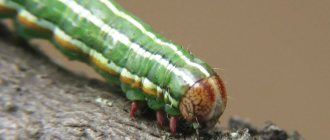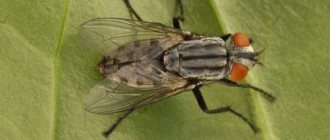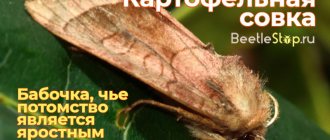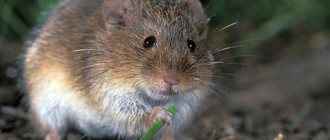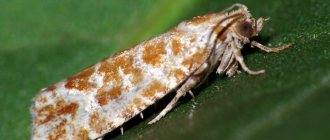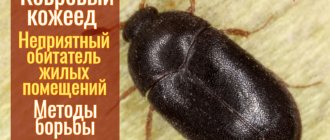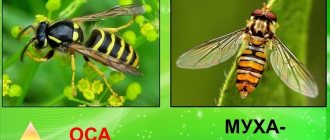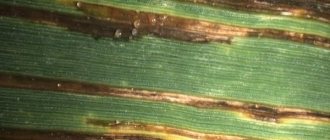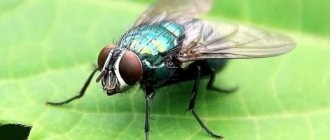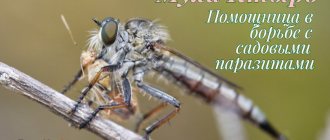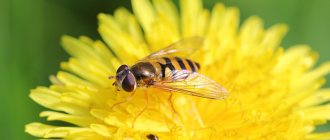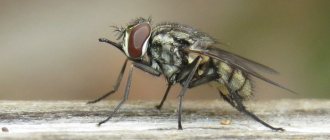Plant protection products
Order: Diptera. Family: cereal flies. Alternative title:
Oscinella frit, O. pusilla.
The Swedish fly is a well-known crop pest that damages corn, barley, rye, oats, spring and winter wheat. There are several types of Swedish flies, which differ in their diet. The most famous are the Swedish oat fly and the Swedish barley fly. In areas where grain crops are grown, the Swedish fly is ubiquitous.
Preparations used to protect grain crops from the Swedish fly
| Manufacturer | Name | Active ingredients | Consumption rate | Price per liter/kg | Availability |
| Insecticide KARATE ZEON, ISS | 50 g/l lambda-cyhalothrin | 0.1 - 0.48 l/ha | 2508 | ||
| Insecticide EFORIYA, KS | 106 g/l lambda-cyhalothrin, 141 g/l thiamethoxam | 5405 | |||
| Insecticide DECIS EXPERT, CE | 100 g/kg deltamethrin | 0.05 - 0.175 l/ha | 4000 | ||
| Insecticide PROTEUS, MD | 100 g/l thiacloprid, 10 g/l deltamethrin | 2422 | |||
| Insecticide BOREY, SK | 150 g/l imidacloprid, 50 g/l lambda-cyhalothrin | 4064 | |||
| Insecticide BOREY NEO, SK | 125 g/l alpha-cypermethrin, 100 g/l imidacloprid, 50 g/l clothianidin | 4121 | |||
| Insecticide BRAKE, ME | 100 g/l lambda-cyhalothrin | 3112 | |||
| Insecticide SIROCCO, CE | 400 g/l dimethoate | 1094 | |||
| Insecticide TAYRA, CE | 480 g/l chlorpyrifos | 1402 | |||
| Insecticide SHARPEY, ME | 250 g/l cypermethrin | 1539 | |||
| Insecticide Mospilan, RP | 200 g/kg acetamiprid | 0.06 - 0.7 kg/ha | 7781 |
News
Among the complex of phytophagous cereal grains that damage plant stems during the period from germination to grain ripening, about 20 species from four families are widespread in Russia. The most numerous and harmful are representatives of the order Diptera (Díptera) - gall midges, grain flies, flower flies and opomysids, and among grain flies - the Hessian fly (Mayetiola destructor Say.) and Swedish flies: oat flies (Oscinella frit L.) and barley flies (O. pussilla Mg.), less common wheat fly (Phorbia securisTien.) and other species. Diptera phytophages damage plants of winter cereals in the autumn and spring-summer periods, and spring cereals - in spring-summer.
When seedlings are colonized by grain flies, the appearance of damaged plants turns yellow and the central leaf withers. This usually occurs in the 3-4 leaf phase. If the main stem is damaged before the formation of lateral stems begins, then such plants, as a rule, die. This significantly affects the yield of grain crops. As a rule, one plant stem contains one larva, which belongs to one species of cereal flies, with the exception of the Hessian fly, which can live in several larvae.
Swedish fly
Swedish flies belong to the genus Oscinella. In Russia, the main damaged cereal crops are oats, rye, barley and wheat.
The Swedish fly is quite small, shiny black, body size – 1.5-2 mm in length, with a short body. The egg is small, oval in shape, 4-5 mm long and white.
The larvae crawl behind leaf sheaths and penetrate inside the shoots to the base of the stem. In the stem, the larva eats a short upward stroke, reaching the primordium of the ear, which it feeds on. Damaged shoots are characterized by rapid yellowing and wilting of the central leaf; they stop growing and gradually die off. In the phases of germination - the beginning of tillering, flies damage the main shoots, and starting from the phase of emergence into the tube - side shoots. If the larvae damage the main stem, the plant dies, and thus the yield is greatly reduced - by 50%. At the same time, the number of grains in the ear is reduced by 36-66.9%.
Green-eyed
Greeneye (Chlorops pumilionis Bjerk) is found in Siberia, the Far East, and the Altai region of Russia.
The body of the fly is about 5-6 mm long and has a yellow and black color. Clearly drawn longitudinal lines are visible on the back. The eggs of the pest are white and oblong. The length of each is about 1-1.5 mm. The larva is white or light yellow, cylindrical in shape, reaching 9-10 mm in length.
The larvae overwinter in the middle of the stem of winter crops. In the spring they continue to feed. In May they pupate in feeding areas. The flies emerge at the end of May. The laying of eggs coincides with the period of the beginning of trumpeting of ardent cereals - females lay them one at a time, mainly on the surface of the leaves of cereal crops. There are two types of damage to plants by grain flies: in the early phases of plant development, internodes are shortened, stems thicken, growth is retarded, and severely damaged plants die. In more developed plants, the larvae are located in the leaf sheath and gnaw out a longitudinal groove in the stalk of the ear, sometimes damaging the ear itself. This greatly affects the harvest, since the ear is partially or not at all.
wheat fly
Wheat fly - (Fhorbia floralis Meig.) harms in the Leningrad, Samara, Rostov, Volgograd, Voronezh regions, Krasnodar and Stavropol territories, the Volga region and the Urals.
Every year, the wheat fly damages up to 30-70% of the stems of winter and up to 90% of spring wheat.
The wheat fly is a fairly large insect, 3.5-6 mm long, flies well and easily covers significant distances. The body is black with a velvet coating, the wings are black and dark brown, the legs are black.
The egg is white, elongated oval, 1-1.25 mm long. The larvae are whitish or yellowish in color, 6-8 mm long. The larvae overwinter in the soil at a depth of 3-5 cm, between the roots of damaged plants, and also next to them. At the end of February - beginning of March, the larvae pupate.
It begins laying eggs on the stems of spring tillering, mainly in late sowings of winter wheat, in mid-April. In the last ten days of May they go into the soil, pupate and enter summer diapause. The wheat fly causes the main damage in the fall, as well as during periods of insufficient moisture.
Hessian fly
The Hessian fly - Mayetiola destructor is common in the European part of Russia, in the south of Siberia and the Far East. It mainly damages crops of winter and spring wheat, and less commonly rye and barley. It causes the greatest damage in the steppe regions of the Central Black Earth Zone and the North Caucasus.
Damage caused by the Hessian fly to plants is most dangerous during the germination phase. This can lead to the death of the stem or even the entire plant. With later damage by larvae to productive stems, yield losses can reach about 23-66%.
The Hessian fly is reddish-brown in color, 2.5-3.5 mm in size; looks like a small mosquito. The wings are smoky-dark with three longitudinal veins. The abdomen of the female is ovoid-pointed, while that of the male is cylindrical. The egg is 0.5 mm in size, cylindrical.
The Hessian fly causes two types of damage on spring and winter grains:
- Damage to young plants before they emerge into the tube; at this time, the damaged stems are slightly thickened, the leaf blades are expanded. At first the stems are darker in color, then they turn yellow and die.
- After emerging into the tube, the damaged stems do not die, but continue to grow, but at the site of damage they become thin, bend and droop; drooping stems tend to straighten and give geniculate bends.
The reproduction of the Hessian fly is also facilitated by periods of insufficient moisture. In the non-chernozem zone, due to lack of heat, there are no favorable conditions for the mass reproduction of this fly.
Thus, the above types of cereal flies cause great damage, so it is necessary to take measures to prevent their spread and damage to cultivated plants.
Measures to combat cereal flies
Agrotechnical methods
Calibration of grains before sowing and selection of the most varietal seeds gives stable and strong seedlings that are able to resist pests and are damaged to a much lesser extent.
The application of balanced mineral fertilizers in the presence of good soil moisture promotes rapid growth of seedlings and accelerates the ripening of cereals, making them less susceptible to damage, since they sooner become coarser and become unsuitable for feeding by fly larvae.
For prevention, it is advisable to place crops with grain crops after legumes or row crops. The best precursor for sowing grain is clean fallow.
To reduce the level of infestation, it is necessary to carry out the sowing campaign as early as possible, then the cereals have time to survive the critical phase of colonization by fly larvae.
Careful post-harvest work, such as stubble peeling and early deep plowing, which should be done to a depth of at least twenty-two centimeters, is also important. High-quality autumn plowing can destroy a colony of grain fly larvae on stubble and carrion.
Chemical methods
Since this type of fly penetrates the stems of agricultural plants and, while there, actively feeds, it is best to use systemic preparations. Among the systemic insecticides that fight grain flies, we can offer the following drugs:
Operacot Acro (imidacloprid, 300 g/l, lambda-cyhalothrin, 100 g/l) will work most effectively against grain flies. This is an insecticide with both systemic, contact and intestinal action, applied at a consumption rate of 0.05-0.1 l/ha. Its advantage is that it penetrates into the plant and also remains on the surface, thereby providing double protection for the plant against grain flies. Their death occurs within 30 minutes after treatment due to the fact that the drug affects the nervous system of the insect and leads to its death.
Fostran (dimethoate, 400 g/l) is also highly effective against grain flies. This is an organophosphorus insectoacaricide, which, when used on cereal crops with a consumption rate of 1.0-1.5 l/ha, acts for 10-15 days, affecting the central nervous system of the insect and transferring it to a state of paralysis.
Zenit (imidacloprid, 200 g/l) is a systemic-contact drug that fights grain flies on grain crops with a consumption rate of 0.25 l/ha. When used, harmful insects develop paralysis and convulsions, leading to their death. The effect of using the drug can be observed from the first hours after treatment.
Also, to combat cereal flies, we can recommend contact-intestinal preparations, such as:
Operacote (lambda-cyhalothrin, 50 g/kg) works by spraying during the growing season in an amount of the drug of 0.15-0.2 kg/ha. This is a contact-intestinal insecticide to combat cereal flies: it protects the plant for 1-3 weeks, and the death of the insect occurs 30 minutes after treatment.
Newstar (zeta-cypermethrin, 100 g/l) is a safe contact-intestinal insecticide that works for 2 weeks at a consumption rate of 0.07-0.1 l/ha. It leads through the nervous system of harmful insects to their death, which occurs immediately after treatment - the drug has a pronounced knockout effect due to the high rate of toxic action. At the same time, the drug is very economical and also non-phytotoxic.
Praktik (diazinon, 600 g/l) is an organophosphorus insecticide with contact-intestinal action. The recommended application rate of the drug is 1.5 l/ha, while paralysis with subsequent death of insects occurs within 30 minutes after treating plants with the drug. The advantage of this drug is that it can be used in cool times - the minimum temperature threshold is +2°C.
Nurimet Extra (chlorpyrifos, 500 g/l + cypermethrin, 50 g/l) - organophosphorus compounds and synthetic pyrethroids. The recommended application rate of the drug is 0.6-1.5 l/ha. The death of the insect occurs within 3-7 hours (depending on climatic conditions, the type and physiological state of the pest, the period can increase to 2-3 hours).
Thus, it is quite possible to work with grain flies, the main thing is to choose the right drug, its application rate, and apply it within strictly designated periods.
FOR ANY QUESTIONS ABOUT SELECTING PROTECTIVE MEANS, YOU CAN CONTACT, WE WILL BE HAPPY TO HELP YOU
Appearance of the Swedish fly
An adult Swedish fly is small in size - the body reaches 1.5-2 mm in length. The body of the Swedish fly is short, has a convex mesonotum and a shiny black color. The legs of the oatmeal Swedish fly are black, the tibiae of the front and middle legs of the barley Swedish fly are yellow. The wings of the Swedish fly are transparent greenish with a metallic sheen.
The Swedish fly egg is small. It has an elongated oval shape and can reach a length of 0.6-0.8 mm. The larva of the Swedish fly is 2 times larger than the fly - its length reaches 4-5 mm. The larva is legless, has an elongated cylindrical body, yellowish-white or white in color. Instead of legs, the larvae have small spines, with the help of which they move. The Swedish fly pupa is hidden, in the puparia. The pupa can reach a length of 2-3 mm and have a different shade - from brown to yellowish.
Other pests of winter wheat in seeds, plantings and warehouses
The number of cereal pests is very large. Let's talk about those causing the greatest harm.
bug turtle
The insect prefers to feed mainly on wheat, damaging crops of both winter and spring crops . Externally it looks like a tiny turtle. The development cycle of the bug is directly related to the growing season of cereals, so throughout the entire summer period the turtle leads an active lifestyle, causing significant damage both in the fields and in storage facilities.
bug turtle
Trips
Wheat thrips damages winter and spring wheat , as well as some cereal perennial grasses. Both adults and larvae are harmful. The insect feeds on fresh juice from the spike scales or from a young succulent leaf, as a result of which the cereal stops growing.
The grains in the ear receive severe damage - they become chipped and defective, which affects the overall quality of the seed. Externally, thrips is a small black-brown fly with poorly developed wings and a size of 1.3-1.5 mm.
Wheat thrips
Ground beetle
The bread ground beetle causes the greatest damage to winter wheat . The larvae of this pest begin their activity during the period of rising and beginning of tillering of seedlings. They eat leaves and young stems, turning wheat bushes into soaked fiber. Adult beetles infect the ears. They gnaw the scales of the ear, the rudiments of the grains, and gnaw out the ripening grains.
The insect size is 12-17 mm, color is pitch black with a bronze tint . The head is large, the antennae are short, the elytra are convex with deep punctate grooves.
Ground beetle
Weevil
The beetle's mouthparts are an elongated proboscis . With its help, the insect destroys the dense skin of grain or cereal. The weevil is considered one of the main and most dangerous pests of grain crops - wheat, barley, buckwheat, corn, as well as pasta; it destroys stocks both in the kitchen and in huge grain storage facilities.
The insect has an elongated body measuring about 4 mm, dark brown, almost black in color . If it has wings, it is not adapted for flight, but it moves long distances on ships and trains carrying industrial batches of grain.
Weevil
Symptoms of damage to grain crops by the Swedish fly
Oat swedish fly
The larvae cause great damage to grain crops. They crawl behind the leaf sheaths to the base of the stem inside the shoots and eat a small upward passage to the ear bud, on which they feed. The shoots of plants that have been damaged by the Swedish fly larva quickly turn yellow, and the central leaf withers. At the same time, the plants stop growing, which leads to gradual death.
Reasons for appearance
The main reason for its widespread appearance is the ability to adapt to different climates . There are other factors that contribute to the spread of the population on winter wheat:
- Long warm autumn . The period of pest activity increases (at a temperature of +10°C, the insect already goes into hibernation).
- Aridity . Dry weather promotes active growth and development of larvae.
- Nutritional conditions for the growth of winter crops. The more food that enters the plant, the stronger it is, and the stages of development occur much faster. Consequently, the Swedish fly’s period of eating the plant is reduced, since it causes damage at a certain phase of the crop’s growing season.
- Favorable temperature for the period of larval growth (above +10 °C).
- The ability of an insect to migrate over long distances.
Symptoms of the lesion
First of all, the larvae influence the development of the stem . The central leaf withers and turns yellow, sometimes it is completely absent: it either falls off or does not come out of the leaf sinus. External signs of damage caused by the Swedish fly appear approximately two weeks after the larvae settle.
The plant tries to direct forces to the damaged areas, so the color of the leaves becomes intense green and the stems thicken. Using this feature, specialists accurately determine the presence of the Swedish fly in wheat fields.
Development and reproduction of the Swedish fly
The larvae of Swedish flies, which have completed their development, overwinter inside the shoots of winter crops, cereal weeds and carrion seedlings. In the spring, the larvae pupate, after which the adults begin to emerge by early May. Adult flies live from 1 to 1.5 months. Female Swedish males lay eggs on young shoots that have 2-3 leaves, usually on the coleoptile. Each female lays approximately 50-60 eggs at a time. Within a day, the hatched larvae crawl behind the leaf sheath, after which they penetrate into the shoots of plants. They then pupate in shoots, after which adults emerge. In one year, from 1 to 5 generations can develop.
What does the pest eat?
Adults prefer:
- nectar of flowers of buckwheat, lupine, yellow colza, anise and many other types of flowering plants, including dandelions. (Flies have a highly developed sense of smell and finding a flowering field is not difficult for them.);
- protein food - flies do not deny themselves the pleasure of feasting on the smallest aphids;
- molasses - sweetish nectar of flowering plants.
Control measures for Swedish fly
Swedish fly larva
To prevent the appearance and control of Swedish flies and their larvae on grain crops, it is recommended to carry out the following measures:
- compliance with crop rotation,
- use of high-quality seed material,
- spatial isolation of spring wheat crops from winter wheat,
- destruction of cereal weeds,
- feeding with fertilizers,
- optimal seed placement depth,
- post-harvest stubble peeling,
- growing pest-resistant varieties,
- sowing grain crops at optimal times,
- use of insecticides.
Large grain aphid Sitobion avenae F.
The body is 2.5-3 mm long, yellowish-green in color with long legs; antennae longer than body. Winged females have a blackish-brown chest and a green abdomen. The larva is imago-like.
1. Order Homoptera
3. Distribution everywhere, cereals
4. Egg overwintering phase
5. Wintering place on the leaves of winter seedlings, on carrion and wild cereals
6. Developmental biology The larvae hatching in May transform into wingless female founders. During the growing season, they reproduce parthenogenetically, that is, without the participation of males and without fertilization, they give birth to larvae (viviparity) without laying eggs. When nutritional conditions deteriorate (approximately in the 3rd generation, 2nd ten days of May), winged female dispersers appear, which fly to less hardened spring grains. In August, female stripers appear. In September, they give birth to males and females in winter crops, which after mating lay 2-4 eggs, up to 12 (for the winter). Aphids reach their greatest numbers and harmfulness during the heading period - milky ripeness.
7. Number of generations 10-12
8. Harmful phase of larva and imago
9. The nature of the damage caused is by sucking the juices out of the leaves and stems. Leaves become discolored, turn yellow and die. They colonize green ears and suck out the juice of their various parts (the weight of the grain decreases). When plants are planted before heading, they do not head. Virus carriers.
10. EPV: 5-10 aphids / 1 stem (ear) and colonization of more than 50% of plants (exit into the tube - heading), 20-30 aphids / 1 ear (filling grain)
11. Natural enemies are beetles and larvae of ladybirds, larvae of lacewings and hoverflies
12. Control measures – stubble peeling, fall plowing; – early sowing of spring and early ripening varieties; -use of fertilizers (phosphorus) that accelerate and enhance development
– spatial isolation of winter crops from spring crops
– when the EPV is exceeded in the phases of exiting the tube – heading and grain filling, the following preparations are used: fastak 0.1 l/ha, decis-extra 0.05 l/ha, actellik 1 l/ha, karate 0.2 l/ha, Bi -58 New 1-1.2 l/ha, senpai 0.2 l/ha
Fighting methods
The damage caused by insects can be significantly reduced with the correct choice of means of combating it.
Agrotechnical
The most effective ways:
- Maintaining crop rotation . The best predecessors: legumes (clover, alfalfa, peas, soybeans, vetch-oat mixture), corn, annual grasses except sorghum and Sudan grass. It is not advisable to sow wheat on one plot for more than two years.
- Selection of stable seed material with strong fiber that protects the ear from damage by larvae.
- Sowing late varieties (for example, Mirostan, Chaus, Krasnodol) at the optimal time so that winter crops begin to rise with the onset of frosts, when flies hibernate.
- Increasing the grain sowing rate, so that out of the number of sprouted ears, most of them survive and the harvest remains at the same level.
- Deep plowing of the soil.
- Application of nitrogen fertilizers to fields with winter crops to increase plant viability.
Chemical
During the egg-laying and mass summer periods, chemical treatment of wheat is carried out . Using aviation, winter crops are pollinated when their development is in the first leaf phase. In many areas, 12% hexachlorane dust is widely used.
The population of harmful insects is reduced when plants are sprayed with organochlorine and organophosphorus agents. Insecticidal preparations are also used, for example, “Cruiser” and “Celest Top”.
Attention! The death of the fly after treatment reaches 93%, the yield increases by 20% or more.
How does a fly eat
The oral apparatus of this insect is an oblong tube; in blowflies, the so-called teeth are located at the end. With the help of the proboscis, the insect draws in food. If the food is hard, a special secretion is initially injected, which breaks down the food. There is no digestive apparatus as such. Digestion is carried out externally, the fly absorbs already processed food.
The larvae feed in the same way. The substance they secrete is a powerful antibiotic. This ensures their free existence along with a large colony of harmful microorganisms.
Stages of development
Most insects are characterized by developmental metamorphosis in several stages. The fly is no exception. In the life of this insect, all the traditional four stages are present, during which this pest goes through its entire life path.
So, let's list these 4 phases of life and development of a fly, they are as follows:
- egg;
- larva;
- chrysalis;
- adult.
Now let's go through each of these four stages in more detail. Let's find out how long it takes an insect to pass through each of them, and how they are characteristic.
Egg
As already mentioned, one female fly can lay up to 120 eggs at a time. Usually, for laying, these insects choose the places most suitable for the survival of their offspring in the first stage of life.
These include:
- all kinds of human waste;
- cattle manure and domestic animal excrement;
- corpses of dead animals;
- cesspools;
- rotten fruits and vegetables;
- rotten meat products.
During this one day, fly eggs that do not exceed 2 mm. in length, nourish the embryos located inside with yolk. After which, about 24 hours later, larvae emerge from the eggs.
Larva
Like a fly walking on the ceiling.
The larvae that have just hatched from the eggs resemble thin white threads that can barely be seen with the naked eye. When asked how long it takes for the larva to move to the next stage of development, let’s say that the insect usually stays in this state for about a week, more often not even more than 5 days.
The larva is usually very difficult to detect, since it avoids exposure to direct sunlight and tries to burrow as deeply as possible into the environment in which it was born. In the thickness of the nutritional substance, the larva gains the calories it needs for development.
It becomes fatter, becomes larger, changes its pale color to a brownish tint, after which it pupates, making the transition to a new stage of its existence.
Doll
The most passive stage of an insect's life is the stage of being in the form of a pupa. A fly pupa is formed by hardening the skin of the larva, which becomes the pupal case or puparium. Inside this case, the final metamorphosis occurs, during which the tissues of the larva disintegrate and a restructuring of all its systems occurs.
This is how the adult individual (imago) is formed, so familiar and easily recognized by everyone. How long does this transformation process take? Just 5 days, and another buzzing pest is born in all its “glory.”
Preventive measures
To prevent blowflies from breeding, you must follow certain rules:
- In places where the garbage can is located, the soil must be concreted and asphalt laid. This will prevent the larvae from completing their life cycle.
- It is necessary to ensure timely disposal and removal of waste that attracts insects with the smell of rotting. During the warm season, you need to take out the trash from your apartment every day.
- Do not leave meat products lying on tables. To prevent females from laying eggs or maggots, you need lard and rub the meat with salt. The best option is to quickly put it in the freezer. Beef, pork, chicken, etc. may be affected.
- If you want to cook lightly salted fish, you should add more salt to the brine than is required in the cold season. In this way, the product can be protected from malicious worms.
- In the warm season, it is recommended to install mosquito nets on windows and doors, which will protect against many pests from entering the house.
- On livestock and poultry farms, it is necessary to ensure sewage drainage.
To prevent disease and intestinal infection, you need to strictly follow the rules of personal hygiene and food handling. Wash your hands with soap, rinse vegetables, fruits, and herbs thoroughly under running water or pour boiling water over them.
What kind of flies can you find in the house?
It has not yet been established exactly how many species of flies live in nature. The family of these dipterans has several hundred species. However, not all of them need proximity to humans. Among them, those living in the wild stand out, but the number of synanthropic species, at the ecological level associated with human settlements, is impressive.
Fly
Synanthropus insects pose a potential threat to human health, which is largely due to what the flies eat. According to the nature of food consumption of adults, several groups are distinguished, and in each of them the specific type of nutrition of the adults corresponds to the method of feeding of the larvae.
So, the following groups of these dipterans live near humans:
- Coprophagous - This type feeds on human and animal excrement and food waste. Plant sap is what flies feed on in nature, an additional food resource. The most common species are the grassland Muscidae and the brownie.
- Hematophagous - these dipterans in the adult stage prefer human and animal blood, sweat, blood and ichor oozing from wounds, and the larvae require excrement or decomposing animal remains and plant remains. Common representatives are the market fly and the autumn fly.
- Polyphages are insects that, as adults, feed on human excrement and food, waste, and secretions from wounds and mucous membranes. The housefly is a typical representative of this type.
House flies and house flies are the most common in homes, but pasture flies, market flies, and autumn flies also enter the house. Usually, with the onset of cold weather, insects disappear; an ambient temperature of 23 degrees Celsius is comfortable for their life.
See also: Review of the most effective fly repellent tapes
Feeding process in flies
What do flies eat? These dipterans are considered practically omnivorous. And the lack of teeth is not a hindrance. The feeding process involves a long proboscis - a kind of tongue divided into two tubes. It is through them that the food that the fly eats is absorbed.
Feeding process in flies
This is interesting, but without exaggeration these insects can be called gourmets - they do not eat everything. On the paws of an adult individual there are taste buds that allow you to taste food before the proboscis gets involved.
What do flies eat in the house? It is most convenient for insects to eat liquid food, since solid food is more difficult to eat. The indoor snack lover spends too much energy on eating and digesting it: first, solid food is abundantly moistened with saliva, and only then penetrates the digestive tract.
Typically, these dipterans are not capable of sucking human blood, but the mouthparts of the housefly, which is very similar to a housefly, are designed in a special way. The proboscis, strongly elongated and equipped with chitinous “teeth” at the end, scrapes off the epidermis by friction and lets saliva into the puncture. The zhigalka not only feeds on blood, but also leaves irritation at the site of the bite.
What foods do flies prefer?
There is what flies feed on most readily, and there is food that is used only in the absence of the preferred one. Thus, “favorite” foods include sweet foods: jam, compotes, juices, honey, etc. For the larvae to mature, flies need protein food, and here preference is given to meat, fish, etc., especially decomposing and spoiling foods.
Human housing is an ideal “dining room” for flies, and the food here is very varied. They use ready-made dishes that are not protected by lids and packaging, food waste, and when accessing the toilet (relevant for private homes), excrement. And this is not all that flies eat at home. Animal bowls, children's pots with excrement that were not removed in time, rotting fruit - all this also serves as a place for a feast.
Stem borer
This parasite lives in the steppe and forest-steppe zones of Ukraine and Russia. Under favorable conditions, these insects can produce up to 3 generations per year. Particular harm to plants is caused by caterpillars, which damage all parts of the crop, including stems, panicles and cobs.
Pests begin to pupate in the middle or end of spring, when the air temperature rises to +15 degrees. The flight of butterflies coincides with the throwing out of panicles on corn. During this period, insects begin to lay eggs at the bottom of the leaves, 400 eggs per nest. After hatching from the eggs, the caterpillars begin to actively feed on plant cells; they gnaw tunnels in the stems and cobs, as well as on the panicles.
The first signs of damage are yellowing of stems and leaves. The threshold of harmfulness is considered to be the placement of 5-6 caterpillars per square meter of field. Intensive development of parasites leads to breaking of stalks and heads of corn in windy weather.
Description
The body surface of the stem moth caterpillar is yellow with a gray tint; there is a dark stripe on the back of these parasites. The butterflies are quite large, their wingspan reaches 3.5 centimeters. In females, the front wings are white with a yellowish tint or brown, the hind wings are light. The wings of male moths are grayish or brown.
Fighting methods
Low cutting of corn stalks during harvesting, as well as deep plowing of the soil with plant debris, helps prevent the appearance of pests. You can also fight stem borer with special chemicals. For example, the Karate insecticide at a dosage of 200 grams of active substance per hectare of crops is used to treat corn plantings before butterflies lay eggs. Another way to prevent the appearance of parasites is to use resistant varieties.
Morphology
Imago . The fly is 1.5–2.5 mm long.[6] Color black. The base of the abdomen is yellow below, the legs are black with yellow paws. The height of the cheeks at the narrowest point is less than the length of the third antennal segment, but greater than the diameter of the tibia at the apex. The ratio of the lengths of the II and III segments of the arista is 0.52 – 0.57. The wings are transparent.[2]
Sexual dimorphism . Individuals of different sexes differ in the structure of the genital organs. The structure of the genitalia of males and females is used to accurately determine the species.[1]
Egg 0.7 – 0.16 mm. The shape is elongated cylindrical. Color white or cream.
The larva consists of 13 clearly distinguishable segments. The color of the completed larvae is whitish-yellow, the body shape is cylindrical. The body is pointed in front, rounded behind. On the anal segment there are two fleshy rounded tubercles with spiracles having three spiracular slits. On the cuticle of each segment the main row of spines is absent, in contrast to the larva of the Swedish barley fly (Oscinella pusilla). Sometimes remains of spines are observed in the form of one or two stripes at the edges of the ridge. The closing zone is formed by one or two stripes of small spines. Length 3 – 4 mm.[2]
Doll . Puparium length 1.75 – 3 mm, width 0.8 – 1.3 mm. Cylindrical shape, brown color. There are four teeth in the anterior part and two processes at the posterior end.[6]
| Phenology of development (in days) | |
| Transformation | Complete |
| Full cycle | 22 – 46 |
| Egg (embryo) | 5 – 38 |
| Larva | 20 – 28 |
Morphologically related species
In terms of morphology (appearance) of the imago, the Swedish barley fly (Oscinella pusilla) is close to the described species. It differs in that the ratio of the length of the second segment of the arista to the third is 0.27 - 0.31. In addition, the halteres, abdominal sternites, tibiae of the fore and middle legs are colored yellow, and a narrow darkened band is noticeable on the hind legs. Until recently, the Barley Swede Fly and the Oat Swede Fly were identified as variations of the same species.[2]
In addition to the indicated species, Oscinella nigerrima is often found in Western Europe, also similar in adult morphology to the Swedish oat fly (Oscinell afrit).[1]
